Paris rooftops abuzz with beekeeping
Loading...
| PARIS
In the romantic city of lights, the bees are downright busy.
Common sense says it is better to keep hives of stinging insects in the countryside, away from city centers packed with people. Yet on storied rooftops and public gardens in the urban jungle of Paris, the bee business is thriving.
Bees are disappearing from fields across France and elsewhere in the world, victims of a slow decline in number because of loss of habitat compounded by a recent and mysterious catastrophe variously blamed on disease, parasites and pesticides.
But in the heart of the French capital, Nicolas Geant is preparing to sell off his honey. It comes from hives on the edges of the soaring glass roof of the Grand Palais exhibition hall, just off the Champs-Elysees.
"Paris has many balconies, parks and avenues full of trees and little flowers that attract many bees for pollination," says Mr. Geant, who has 25 years of experience under his belt.
The Grand Palais beehives went up in May. They also sit in the Luxembourg Gardens, on the gilded dome of the 19th Century Palais Garnier and the roof of the ultramodern Opera Bastille.
"In Paris, each beehive produces a minimum of 50 to 60 kilograms (110 to 130 pounds) of honey per harvest, and the death rate of the colonies is 3 to 5 percent," says Henri Clement, president of the National Union of French Beekeepers.
"But in the countryside, one beehive only gives you 10 to 20 kilograms (about 20 to 40 pounds) of honey, and the death rate is 30 to 40 percent. It is a sign of alarm."
The Luxembourg Gardens' hives alone produce more than half a ton of honey per harvest. It is sold to the public during the last weekend in September, and the income funds beekeeping classes and the facilities.
Alain Sandmeyer, a volunteer instructor at the gardens, says trees and shrubbery have grown sparser in rural areas, attracting fewer bees. Also, he says, rural bees are dying off from pesticides and fertilizers. In Paris, on the other hand, pesticides are forbidden in all parks and gardens.
Urban beekeeping isn't just a Paris thing. Berlin, London, Tokyo, and Washington, D.C., are among beekeeping cities. New York City on the other hand, lists bees as "venomous insects," and beekeeping is punishable by a $2,000 fine.
Parisian Erin Langenburg, a student, says the bees don't bother her when she's in Parisian parks, but they do tend to migrate to outdoor restaurants. "There seem to be a lot of bees when I'm eating outside on a terrace and they annoy me, especially when they get in my drinks," she says. "I am kind of scared of getting stung by one."
For many years bee experts worried about an aging population of beekeepers, but a new young generation has suddenly taken on the hobby, says May Berenbaum, head of the entomology department at the University of Illinois.
"There's definitely been an incredibly heartening increase in interest," Ms. Berenbaum says.
Domesticated bee populations worldwide have dropped significantly since the late 1940s. The causes have been mostly loss of habitat, disease, fungi and invading parasites, says a 2007 study by the U.S. National Academy of Sciences.
It is estimated that half of the honeybee population has disappeared in the U.S. and Britain, according to an April report from the International Bee Research Association.
And lately the world has been hit by a new crisis, called colony collapse disorder. In 2007-2008, it caused the loss of 35 percent of U.S. bees.
Wild bee populations have also plunged, with disease and loss of habitat being blamed. Last year, 30 percent of Europe's 13.6 million beehives died, according to statistics from Apimondia, an international beekeeping body.
A conference last week in Montpellier, France was told that Ireland had a 53 percent drop in bees in 2006, Slovenia lost 30 to 35 percent of its bee colonies last year, and Italy 37 percent.
It's not just about honey. The US Agriculture Department estimates a third of our diet comes from sources pollinated by insects, primarily bees. The French beekeepers' union reckons 65 percent of agricultural plants worldwide risk not getting pollinated. The US has had to import huge numbers of bees from Australia to pollinate apple orchards and berry fields.
In the Luxembourg Gardens, beekeeping has been going on since 1856. Today, for around €160 ($230), Parisians can spend several months learning about and participating in beekeeping and honey-extraction.
Volunteer instructor Dominique Castel, has been giving all his free time to beekeeping at the gardens since retiring from his aviation industry job 12 years ago. Asked if he gets stung often, he shrugged and said: "You get used to it."
– AP Science Writer Seth Borenstein contributed to this report from Washington, D.C.
Editor’s note: If you’d like to read more about urban beekeeping, check out this Monitor article.
For more on gardening, see the Monitor’s main gardening page, which offers articles on many gardening topics. Also, check out our blog archive and our RSS feed. You may want to visit Gardening With the Monitor on Flickr. Take part in the discussions and get answers to your gardening questions. If you join the group (it’s free), you can upload your garden photos and enter our next contest. We’ll be looking for photographs of fruits. So find your best shots of summer’s blueberries, peaches, plums, etc., and get out your camera to take some stunning shots of early fall apples. Post them before Sept. 30, 2009, and you could be the next winner.





